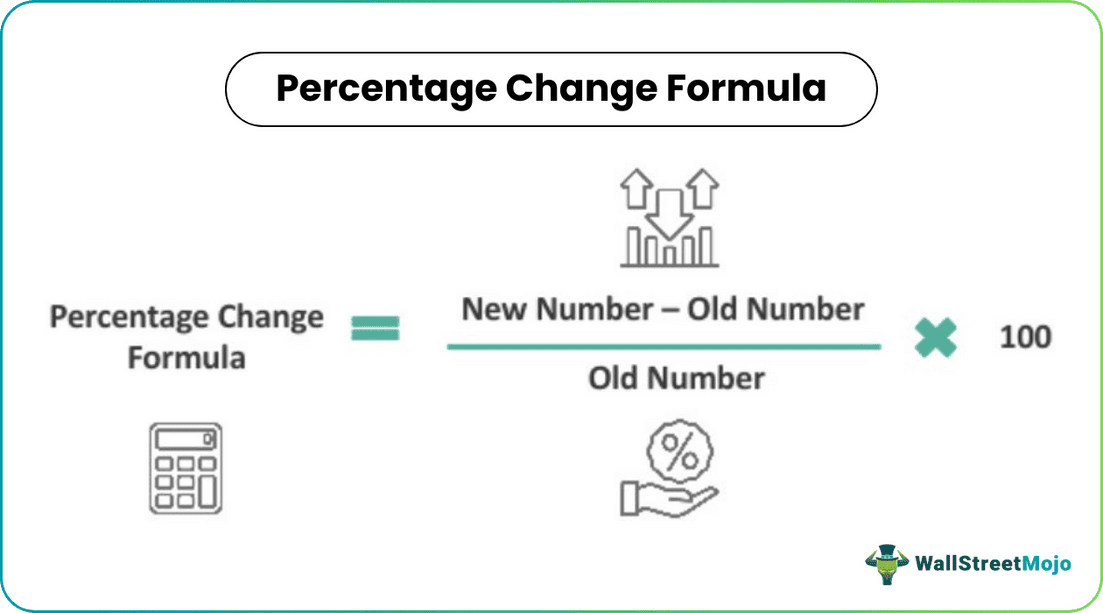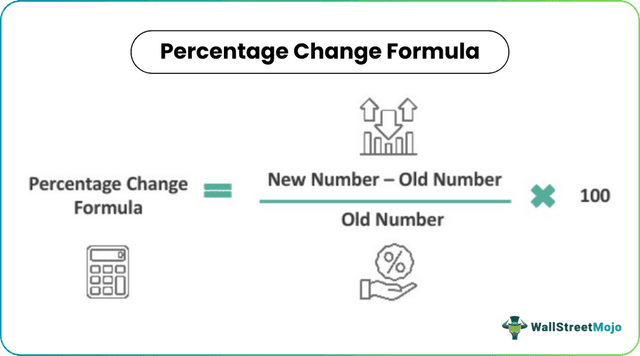Table Of Contents
What is the Percentage Change?
Percentage Change can be defined as a shift in value in % due to changes in the old number and new number, and the values can either increase or decrease and so the change can be a positive value (+) or a negative value (-). The net percentage change formula is widely used in the world of finance to see the shift in investments.

The widest use of this formula in the world of finance and business is to check the percentage growth or decline of stock in the stock market. However, it is used to compare the changes in currencies or even in balance sheets of corporations comparing financial statements from previous years or quarters.
Key Takeaways
- A percentage change refers to the difference in value between old and new numbers, which can lead to increases or decreases. This results in either a positive (+) or negative (-) variation.
- The perception of a positive outcome depends on the context. For instance, if a result is advantageous, it's considered excellent. However, in sales comparisons, a positive outcome might indicate an unfavorable result.
- A negative comparison result isn't necessarily unfavorable when the intention is to enhance a specific aspect.
Formula
Let us understand the percentage change formula economics by first understanding the formula. This shall act as the basis for all the related concepts we would discuss in this article.
Percentage Change = (New Number - Old Number)/Old Number * 100
Looking at the simplicity of this formula, the outcome of this formula must be interpreted correctly. Its outcome can be two types of values:
Positive Value
Even though the positive outcome cannot be interpreted as favorable results, it depends on the input we used in the formula. For example, we used this formula in a cost comparison of two years. If the outcome is positive, then the results are favorable. But on the other hand, if the outcome of a sale comparison is positive, then the result cannot be said favorably.
Negative Value
Prima facie negative values cannot be said unfavorable results every time. If we desire an increase in the value of a particular item, a negative outcome of comparison cannot be said to be unfavorable results.
The formula has to be used carefully. The position of the old value and a new value can be interchanged as follows:
New Number - Old Number/Old Number * 100
But the outcome of this equation has to be interpreted vice-versa to interpretation explained above.
Examples
Let us understand the concept of the net percentage change formula with the help of a few examples. These examples will help us understand the intricate details of the concept and give us in-detail insights.
Example #1
Company XYZ, in the first year after its incorporation, made a profit of $ 15 million, and in the next year, its profits increased to 16.5 million. What is the percentage change in its profits?
Solution
Use below given data for the calculation.
- Old Number: 15
- New Number: 16.5
A calculation can be done as follows-

=(15-16.5)/15*100

- = -10%
It can be interpreted as value has increased by 10% from the old number.
Example #2
Now let us take an example of an organization analyzing its financial statements for the current year and comparing them with the previous year's figures. Its profit and loss statement for the current year shows a sale of $ 4,950,000, and its profit appears to be $294,944. However, its sale in the previous year was $5,475,000 and a profit of $ 175,500. What is the percentage increase or decrease in organization profit and sales?
Solution
First of all, we will calculate the % change in a sale by applying the formula:
Use the below-given data for the calculation.
- Old Number (Current Year Sale): $5,475,000
- New number (Previous Year Sale): $4,950,000
Calculation of change in a sale can be done as follows-

= ($5475000-$4950000)/$5475000

= 9.59 % decrease in sale
Now we will calculate the % change in profit:
- Old Number (Current Year Sale): $175,500
- New number (Previous Year Sale): $294,944
Calculation of percentage change in a profit can be done as follows-

= ($175,500-$294,944)/ $175,500 *100%

= ($175500-$294944)/$175500
= -68.06% or can be interpreted as a 68.06% increase in profits.
Example #3
A startup firm had 30 employees last year, and its total human resource cost was $ 196,500. The company decided to remove five highly inefficient employees to reduce its employee cost. At the end of the year, while analyzing savings in employee cost, it found the total employee cost is $ 195,500. Find out the % change in employee cost due to no employees.
Solution
Use below given data for calculation
- Old Number: 30
- New Number: 25
Calculation of percentage change in no of employees can be done as follows-

=(30-25)/30*100%

= 16.67% or 16.67% decrease in no. of employees
Use below given data for calculation of the change in the employee cost.
- Old Number: 196500
- New Number: 195500

=(196500-195500)/196500*100%

= 0.5%
= 0.5% increase in employee cost.
Importance
Given the fact that percentage change formula economics is found across multiple domains, it is a vital aspect of analyzing returns and movements in values in different time frames. Let us understand its importance through the explanation below.
Percentage change is an important tool to give clarity of thought about the direction. Either change is moving in a favorable direction, or do we need to change our strategies to bring changes per our goals and objectives? As shown in both of the above examples, changes in the first example are favorable but changes in the second example are not favorable in the first example. Even though the strong sales decreased by 9.59%, company profit increased by 68.06%.
It shows that changes adopted by the organization resulted in a favorable outcome. But in the second example, even though the company has removed its five employees still, its employee cost has increased by 0.5%. It gives them clarity of thought that something wrong is happening in the organization.
Percentage Change Calculator
A calculator has been provided below for the perusal of the reader.

